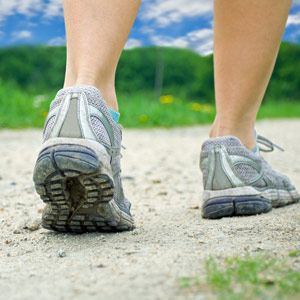
Leaning
Leads to lower backache, fatigue and poor form.
In order to get an idea of the correct posture to adopt while walking, try walking with a short pole held behind the back in the crook of the elbows. Or stand with your back against a wall. Then, lean forward very slightly from the ankles - not from the waist. This is the proper position.
Wrong arm movements and positioning
Leads to excessive fatigue – especially in the upper body.
Some beginners hold their arms too low, which causes a slow and awkward walking style. To avoid this walking flaw, practice the correct arm swing - hands from hip line to nipple line and keep the elbows bent at 90-degrees.
Elbow whipping
Some novice walkers whip their elbows to such an extent that they emulate chickens vigorously flapping their wings. Remember that the arm swing must come from the shoulder, not the elbow.
If this is your problem, you can learn to correct it by putting a long piece of string behind your neck, holding each of the ends in each hand and ensuring that your elbows are bent at the required 90 degrees. Now walk.
If you feel that the string is sliding back and forth against your neck, and probably burning it at the same time, you are whipping your elbows. Practice until you have mastered the technique and eliminated the string burn behind your neck.
Overstriding
If you find that your hat or hair bobs up and down when you walk, chances are that you are overstriding and as such, setting yourself up for injuries, especially shin-splints. Also, every time that your heel hits the ground in a stride that is too long, you are braking the forward motion and hampering your pace.
In order to eliminate the bounce, experiment with shorter stride lengths until you find the correct one that causes you to glide or skim over the surface, rather than bounce and jerk.
Not walking straight
Some walkers turn the feet outward while walking, some allow the feet to cross over with each stride and others walk with the two feet tracking two parallel lines. These are all incorrect and will lead to 'lifting', poor form and sub-optimum pace.
The feet must come down in a straight line. Experiment by walking on a lane marker or painted line on a road. Ensure that both feet come down on this line. You can also check whether you are walking in a straight line, by checking your foot imprints on soft sandy surfaces or on the beach.
For more tips and advice, visit Run/Walk For Life.
Leads to lower backache, fatigue and poor form.
In order to get an idea of the correct posture to adopt while walking, try walking with a short pole held behind the back in the crook of the elbows. Or stand with your back against a wall. Then, lean forward very slightly from the ankles - not from the waist. This is the proper position.
Wrong arm movements and positioning
Leads to excessive fatigue – especially in the upper body.
Some beginners hold their arms too low, which causes a slow and awkward walking style. To avoid this walking flaw, practice the correct arm swing - hands from hip line to nipple line and keep the elbows bent at 90-degrees.
Elbow whipping
Some novice walkers whip their elbows to such an extent that they emulate chickens vigorously flapping their wings. Remember that the arm swing must come from the shoulder, not the elbow.
If this is your problem, you can learn to correct it by putting a long piece of string behind your neck, holding each of the ends in each hand and ensuring that your elbows are bent at the required 90 degrees. Now walk.
If you feel that the string is sliding back and forth against your neck, and probably burning it at the same time, you are whipping your elbows. Practice until you have mastered the technique and eliminated the string burn behind your neck.
Overstriding
If you find that your hat or hair bobs up and down when you walk, chances are that you are overstriding and as such, setting yourself up for injuries, especially shin-splints. Also, every time that your heel hits the ground in a stride that is too long, you are braking the forward motion and hampering your pace.
In order to eliminate the bounce, experiment with shorter stride lengths until you find the correct one that causes you to glide or skim over the surface, rather than bounce and jerk.
Not walking straight
Some walkers turn the feet outward while walking, some allow the feet to cross over with each stride and others walk with the two feet tracking two parallel lines. These are all incorrect and will lead to 'lifting', poor form and sub-optimum pace.
The feet must come down in a straight line. Experiment by walking on a lane marker or painted line on a road. Ensure that both feet come down on this line. You can also check whether you are walking in a straight line, by checking your foot imprints on soft sandy surfaces or on the beach.
For more tips and advice, visit Run/Walk For Life.




 Publications
Publications
 Partners
Partners














